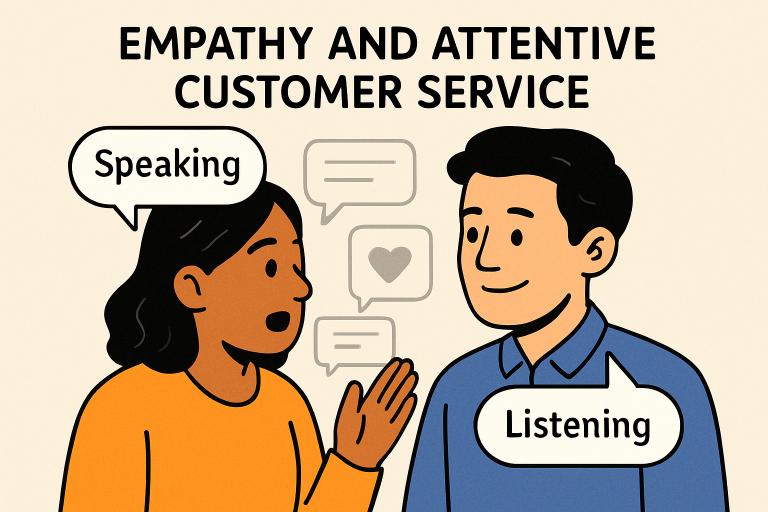Customer Conversations: Shaping Experiences
Every interaction with a customer offers organizations a unique opportunity to leave a lasting, positive impression. The brands that truly resonate don’t just focus on sweeping innovations or impressive policies—they pay close attention to the nuances and details embedded in each conversation. Evidence increasingly shows that these seemingly small aspects are what turn routine encounters into memorable experiences.
Companies that leverage the capabilities of an advanced conversation analytics platform can capture the essence of these conversations, analyze them at scale, and deliver actionable insights for staff. Modern customers expect not just efficient service, but meaningful, attentive exchanges that respond to their individual needs.
According to McKinsey, consistency and personal attention within service conversations have a direct impact on customer satisfaction levels. Investing in better understanding and responding to customer cues allows businesses to differentiate themselves in a crowded market.
The Power of Listening to Customers
Active listening is one of the most underestimated abilities in customer service. Most customers won’t spell out every need; they frequently share subtle hints about their struggles, ambitions, and expectations during even the shortest interactions. Companies that foster a culture where team members truly listen—and not just hear—are better equipped to anticipate needs and exceed expectations.
The significance of listening extends far beyond etiquette. As highlighted by a Harvard Business Review analysis, organizations with well-developed listening skills see higher customer satisfaction and more successful change management. These improvements result from understanding not just words, but intent and emotion—transforming everyday service into a valued, trust-building exchange.
Emotional Intelligence and Communication
Empathy is at the heart of exceptional customer interactions. Emotionally intelligent teams can interpret tone, body language, and even silence to identify what customers are feeling, often before they articulate it themselves. Employees who excel in emotional intelligence can defuse tense moments, build rapid rapport, and enhance loyalty.
This capacity goes beyond politeness or friendliness. It is about genuinely engaging with customer emotions: understanding frustration when things go wrong, and sharing in delight when a problem is swiftly resolved. By embedding emotional intelligence into training and daily operations, businesses set themselves up for deeper, more authentic connections.
Technology and the Human Touch
As digital tools like AI-driven chatbots and automated help desks become commonplace, businesses must balance efficiency with personalized care. Technology, particularly tools that transcribe and analyze real customer exchanges, should enable—rather than replace—the human element.
Platforms that integrate conversation analysis, real-time guidance, and insightful coaching empower teams to personalize each interaction seamlessly. When supported with data-driven prompts and context, employees can combine the reliability of technology with their own empathy and judgment. This harmony ensures no detail goes unnoticed, and every customer feels truly engaged.
Data-Driven Insights in Action
Analyzing the full range of customer conversations at scale opens up transformative possibilities. The best organizations mine these interactions for trends—whether it’s common pain points, emerging topics, or emotional triggers. Insights from advanced analytics inform everything from product development to staff coaching, ensuring that the business evolves based on real-world feedback.
Many global brands utilize data gleaned from conversations—often refined via A/B testing—to continuously improve their communication strategies and address customer concerns even before they escalate. As highlighted by Forbes, the integration of AI-based analytics in customer experience is driving higher satisfaction rates and more responsive service models.
Training Teams for Better Interactions
Ongoing investment in communication skills training produces far-reaching benefits. Effective programs cover everything from active listening to addressing complex, emotional moments in customer journeys. Teams trained to pick up on subtle customer cues can transform even potentially negative situations into positive outcomes.
Real-world examples consistently demonstrate that trained professionals can rebuild trust and satisfaction—even after a misstep—with a simple, heartfelt apology or proactive follow-up. Regular coaching ensures that every employee, regardless of tenure, is equipped to create meaningful moments that customers remember.
Measuring Success in Customer Experience
The metrics organizations choose to assess customer experience will guide their improvement efforts. While customer satisfaction surveys are a baseline, deeper analysis—such as tracking retention, repeat business, and the sentiment within follow-up conversations—offers richer perspectives.
Today’s best-in-class analytics platforms transform spoken or written feedback into measurable sentiment, helping leadership teams understand what’s driving positive (or negative) experiences. Those who act on these actionable insights consistently outperform competitors who rely only on generic post-interaction surveys.
Future Trends to Watch
- Personalization: AI enhancements will enable brands to deliver highly individualized customer journeys—tailoring every touchpoint to history, preferences, and channel.
- Omnichannel responses: Customers now expect seamless handoffs between phone, chat, social media, and email. The companies that make transitions invisible will define the standard for convenience.
- Proactive engagement: Businesses will anticipate questions and solve problems before customers notice them, reaching out with personalized tips, reminders, and proactive check-ins.
The evolution of customer experience hinges on mastering the details within every conversation. Embracing new technology, fostering listening and empathy, and grounding all decisions in data-driven insights will separate tomorrow’s leaders from the rest. Companies that focus on these essential ingredients will transform fleeting moments into lasting customer loyalty—and set the standard for exceptional service in years to come.
Conclusion
The future of customer experience won’t be defined by sweeping gestures alone, but by the small, consistent details within every conversation. Each interaction—whether digital or face-to-face—carries the power to build trust, shape loyalty, and influence long-term relationships. By paying attention to tone, timing, personalization, and genuine empathy, businesses can transform ordinary exchanges into meaningful moments that resonate. In a competitive marketplace where customers remember how they were made to feel, mastering the details of every conversation is what will set future leaders apart.


